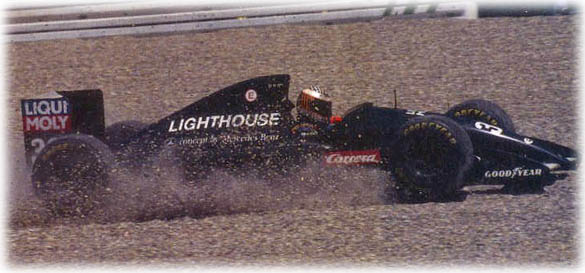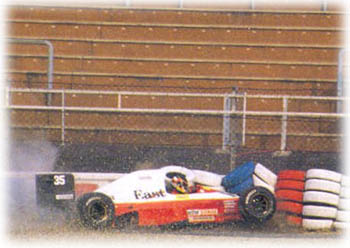|

Modern Formula One tracks have been equipped with gravel traps to decrease the collision speed in the event of an accident.
After Michael Schumacher's high-speed accident in the British Grand Prix, the FIA's track safety group have been assigned with a
job to find out more effective methods to decrease the impact speed.
After the British Grand Prix, many top drivers have commented about the current gravel traps and their ineffectively to slow the car's speed. David Coulthard gave a statement saying, "gravel traps do not work, they only set the car going airborne."
In the Michael Schumacher's accident there was not enough substantial decrease in speed, when he hit the wall. The impact speed was measured by the Ferrari mechanics to be as high as 107 kilometres. When a human is driving a car which slows down
from over one hundred kilometres per hour to zero kilometres in less than three meters, injuries are inevitable.
Why in three meters? In the current gravel trap design a driver will first fly through a 30 meter gravel part and then hit a tyre barrier. Like in Michael Schumacher's accident the real decrease in speed only happened when he hit the tyre wall and normally that tyre wall only bends no more than three meters. Is this the best way to prepare for an accident? Definitely not, but are
there any alternatives? Yes, there are.
The very popular American motorsport of tractor pulling has had the answer for the most effective gravel traps for years.
In tractor pulling, contestants try to drive a bulldozer as far as possible with ever increasing weight in the wagon. Normally,
their speed slows down in just a matter of seconds. In Formula One, the concept of slowing down the speed with increasing
weight towards the ground could be implemented with a different kind of tyre barrier positioning.
 Formula One gravel traps always end up with a wall covered that is covered with a soft tyre barrier. If these tyre barrier chains would be located in the midst of the gravel trap, the driver with one hundred kilometre speed would first collide with the tyre barrier. After being stuck to the tyres, this whole tyre wall would be dragged along the gravel from about fifty sixty meter wide area. Since there is no wall to end the movement of the tyre chain and the car, a more comfortable deceleration of speed would occur and most likely would save the life of the Grand Prix driver. Formula One gravel traps always end up with a wall covered that is covered with a soft tyre barrier. If these tyre barrier chains would be located in the midst of the gravel trap, the driver with one hundred kilometre speed would first collide with the tyre barrier. After being stuck to the tyres, this whole tyre wall would be dragged along the gravel from about fifty sixty meter wide area. Since there is no wall to end the movement of the tyre chain and the car, a more comfortable deceleration of speed would occur and most likely would save the life of the Grand Prix driver.
Not only would the tyre wall slow down the speed, it would also prevent the car flying in air. After all, it is not the driving off-road that kills the driver, but the collision with the wall.
More hands-on example of this physical event can be imagined by comparing the effects of a trampoline. Think of yourself jumping down from a four meter high window to a solid ground. Not very tempting, is it. How about if you would jump down to a massive trampoline, which would slow down your speed more smoothly and then of course would bounce you back up until you would lose velocity entirely and come to a safe halt?
The change from a situation we have now at the tracks to the more effective way would be as cheap as ever. All we need is to move those tyre barriers off the wall and we have a superior deceleration mechanism over the old soft wall idea.
The FIA has been studying the effects of special designed tarmac materials, yet it is remarkable how in a sport so full of engineers the effects of the tyre barriers has been misjudged for so long. Let's move them and give a chance to the next unfortunate driver with faulty brakes system.
| 

